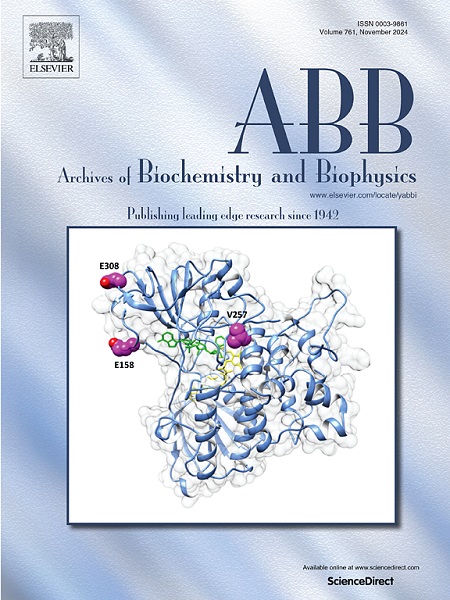匙羹藤皂苷诱导的脂质翻转鉴定耐甲氧西林金黄色葡萄球菌刚性膜表型并增强其抗生素敏感性。
IF 3.8
3区 生物学
Q2 BIOCHEMISTRY & MOLECULAR BIOLOGY
引用次数: 0
摘要
我们之前的研究表明,脂质翻转诱导的植物化学物质来自金螺旋体,增加了金黄色葡萄球菌抗微生物药物的膜通透性。然而,与甲氧西林敏感金黄色葡萄球菌(MSSA)相比,它们对耐甲氧西林金黄色葡萄球菌(MRSA)具有更高氨酰化脂质含量的膜的脂质翻转和膜透性作用尚不清楚。裸子皂苷、裸子酸I和IV显著增加了msa和MRSA的抗生素敏感性。MRSA膜脂质扩散系数为0.0002 μm2/s,而MSSA膜脂质扩散系数为1.48 μm2/s。此外,与MSSA不同,MRSA细胞抑制流体脂质体与其质膜的融合。重组膜囊的体外实验显示,木藤皂苷在MSSA膜中诱导60%的脂质翻转,而在MRSA膜中仅诱导20%的脂质翻转,这表明木藤皂苷诱导的MRSA跨双层脂质流动性明显降低。与MSSA相比,藤皂苷诱导MRSA的结晶紫吸收、细胞蛋白释放、细胞收缩和裂解显著降低。裸子皂苷导致MSSA和MRSA中脂质氨基酰化的剂量依赖性抑制,使其膜比未处理的对照细胞更阴性。硅分析显示,裸子酸I和IV与多肽抗性因子(结合能~ 7.5 kCal)结合,该蛋白在金黄色葡萄球菌中负责脂质氨基酰化。我们的研究首次揭示了与MSSA相比,具有较高氨基酰基pg的MRSA膜具有明显较低的扩散速率和脂质跨双层翻转。此外,裸子酸是鉴定、表征和药物致敏刚性膜MRSA表型的有用探针。本文章由计算机程序翻译,如有差异,请以英文原文为准。

Gymnema saponin-induced lipid flip-flop identifies rigid membrane phenotype of methicillin resistant S. aureus and enhances it's antibiotic susceptibility
Our previous study revealed that lipid flip-flop inducing phytochemicals from Gymnema sylvestre increase membrane permeability of antimicrobials in S. aureus. However, their lipid flipping and membrane permeabilizing effect on methicillin resistant S. aureus (MRSA) membrane that has intrinsically higher aminoacylated lipid content compared to methicillin sensitive S. aureus (MSSA) is poorly characterized. Gymnema saponins, gymnemic acid I and IV significantly increased the antibiotic susceptibility in both MSSA and MRSA. MRSA exhibited a rigid membrane with lipid diffusion coefficient 0.0002 μm2/s compared to the MSSA membrane lipids with diffusion coefficient 1.48 μm2/s. Further, unlike MSSA, MRSA cells inhibited fusion of fluid liposomes with their plasma membrane. In vitro assay on reconstituted membrane vesicles revealed that Gymnema saponins induced 60 % lipid flipping in MSSA membrane compared to only 20 % lipid flipping in MRSA, indicating significantly lower Gymnema saponin-induced trans-bilayer lipid mobility in MRSA. Gymnema saponins induced significantly lower crystal violet uptake, release of cellular protein, cell shrinkage and lysis in MRSA compared to MSSA. Gymnema saponins led to dose-dependent inhibition of lipid-aminoacylation in both MSSA and MRSA making their membranes more negative compared to untreated control cells. In silico analysis reveals binding of both gymnemic acid I and IV to multiple peptide resistance factor (binding energy ∼ 7.5 kCal), the protein responsible for lipid aminoacylation in S. aureus. For the first time, our study reveals that MRSA membrane with higher aminoacyl-PG compared to MSSA shows significantly lower rate of diffusion and trans-bilayer flip-flop of lipids. Further, gymnemic acids are useful probes for identification, characterization and drug sensitization of rigid membrane MRSA phenotypes.
求助全文
通过发布文献求助,成功后即可免费获取论文全文。
去求助
来源期刊

Archives of biochemistry and biophysics
生物-生化与分子生物学
CiteScore
7.40
自引率
0.00%
发文量
245
审稿时长
26 days
期刊介绍:
Archives of Biochemistry and Biophysics publishes quality original articles and reviews in the developing areas of biochemistry and biophysics.
Research Areas Include:
• Enzyme and protein structure, function, regulation. Folding, turnover, and post-translational processing
• Biological oxidations, free radical reactions, redox signaling, oxygenases, P450 reactions
• Signal transduction, receptors, membrane transport, intracellular signals. Cellular and integrated metabolism.
 求助内容:
求助内容: 应助结果提醒方式:
应助结果提醒方式:


